Jianmin Zheng
Normal-GS: 3D Gaussian Splatting with Normal-Involved Rendering
Oct 27, 2024



Abstract:Rendering and reconstruction are long-standing topics in computer vision and graphics. Achieving both high rendering quality and accurate geometry is a challenge. Recent advancements in 3D Gaussian Splatting (3DGS) have enabled high-fidelity novel view synthesis at real-time speeds. However, the noisy and discrete nature of 3D Gaussian primitives hinders accurate surface estimation. Previous attempts to regularize 3D Gaussian normals often degrade rendering quality due to the fundamental disconnect between normal vectors and the rendering pipeline in 3DGS-based methods. Therefore, we introduce Normal-GS, a novel approach that integrates normal vectors into the 3DGS rendering pipeline. The core idea is to model the interaction between normals and incident lighting using the physically-based rendering equation. Our approach re-parameterizes surface colors as the product of normals and a designed Integrated Directional Illumination Vector (IDIV). To optimize memory usage and simplify optimization, we employ an anchor-based 3DGS to implicitly encode locally-shared IDIVs. Additionally, Normal-GS leverages optimized normals and Integrated Directional Encoding (IDE) to accurately model specular effects, enhancing both rendering quality and surface normal precision. Extensive experiments demonstrate that Normal-GS achieves near state-of-the-art visual quality while obtaining accurate surface normals and preserving real-time rendering performance.
Differentiable Convex Polyhedra Optimization from Multi-view Images
Jul 22, 2024Abstract:This paper presents a novel approach for the differentiable rendering of convex polyhedra, addressing the limitations of recent methods that rely on implicit field supervision. Our technique introduces a strategy that combines non-differentiable computation of hyperplane intersection through duality transform with differentiable optimization for vertex positioning with three-plane intersection, enabling gradient-based optimization without the need for 3D implicit fields. This allows for efficient shape representation across a range of applications, from shape parsing to compact mesh reconstruction. This work not only overcomes the challenges of previous approaches but also sets a new standard for representing shapes with convex polyhedra.
ObjectSDF++: Improved Object-Compositional Neural Implicit Surfaces
Aug 17, 2023Abstract:In recent years, neural implicit surface reconstruction has emerged as a popular paradigm for multi-view 3D reconstruction. Unlike traditional multi-view stereo approaches, the neural implicit surface-based methods leverage neural networks to represent 3D scenes as signed distance functions (SDFs). However, they tend to disregard the reconstruction of individual objects within the scene, which limits their performance and practical applications. To address this issue, previous work ObjectSDF introduced a nice framework of object-composition neural implicit surfaces, which utilizes 2D instance masks to supervise individual object SDFs. In this paper, we propose a new framework called ObjectSDF++ to overcome the limitations of ObjectSDF. First, in contrast to ObjectSDF whose performance is primarily restricted by its converted semantic field, the core component of our model is an occlusion-aware object opacity rendering formulation that directly volume-renders object opacity to be supervised with instance masks. Second, we design a novel regularization term for object distinction, which can effectively mitigate the issue that ObjectSDF may result in unexpected reconstruction in invisible regions due to the lack of constraint to prevent collisions. Our extensive experiments demonstrate that our novel framework not only produces superior object reconstruction results but also significantly improves the quality of scene reconstruction. Code and more resources can be found in \url{https://qianyiwu.github.io/objectsdf++}
Multi-objective Anti-swing Trajectory Planning of Double-pendulum Tower Crane Operations using Opposition-based Evolutionary Algorithm
May 30, 2023Abstract:Underactuated tower crane lifting requires time-energy optimal trajectories for the trolley/slew operations and reduction of the unactuated swings resulting from the trolley/jib motion. In scenarios involving non-negligible hook mass or long rig-cable, the hook-payload unit exhibits double-pendulum behaviour, making the problem highly challenging. This article introduces an offline multi-objective anti-swing trajectory planning module for a Computer-Aided Lift Planning (CALP) system of autonomous double-pendulum tower cranes, addressing all the transient state constraints. A set of auxiliary outputs are selected by methodically analyzing the payload swing dynamics and are used to prove the differential flatness property of the crane operations. The flat outputs are parameterized via suitable B\'{e}zier curves to formulate the multi-objective trajectory optimization problems in the flat output space. A novel multi-objective evolutionary algorithm called Collective Oppositional Generalized Differential Evolution 3 (CO-GDE3) is employed as the optimizer. To obtain faster convergence and better consistency in getting a wide range of good solutions, a new population initialization strategy is integrated into the conventional GDE3. The computationally efficient initialization method incorporates various concepts of computational opposition. Statistical comparisons based on trolley and slew operations verify the superiority of convergence and reliability of CO-GDE3 over the standard GDE3. Trolley and slew operations of a collision-free lifting path computed via the path planner of the CALP system are selected for a simulation study. The simulated trajectories demonstrate that the proposed planner can produce time-energy optimal solutions, keeping all the state variables within their respective limits and restricting the hook and payload swings.
ExtrudeNet: Unsupervised Inverse Sketch-and-Extrude for Shape Parsing
Sep 30, 2022



Abstract:Sketch-and-extrude is a common and intuitive modeling process in computer aided design. This paper studies the problem of learning the shape given in the form of point clouds by inverse sketch-and-extrude. We present ExtrudeNet, an unsupervised end-to-end network for discovering sketch and extrude from point clouds. Behind ExtrudeNet are two new technical components: 1) an effective representation for sketch and extrude, which can model extrusion with freeform sketches and conventional cylinder and box primitives as well; and 2) a numerical method for computing the signed distance field which is used in the network learning. This is the first attempt that uses machine learning to reverse engineer the sketch-and-extrude modeling process of a shape in an unsupervised fashion. ExtrudeNet not only outputs a compact, editable and interpretable representation of the shape that can be seamlessly integrated into modern CAD software, but also aligns with the standard CAD modeling process facilitating various editing applications, which distinguishes our work from existing shape parsing research. Code is released at https://github.com/kimren227/ExtrudeNet.
Object-Compositional Neural Implicit Surfaces
Jul 20, 2022



Abstract:The neural implicit representation has shown its effectiveness in novel view synthesis and high-quality 3D reconstruction from multi-view images. However, most approaches focus on holistic scene representation yet ignore individual objects inside it, thus limiting potential downstream applications. In order to learn object-compositional representation, a few works incorporate the 2D semantic map as a cue in training to grasp the difference between objects. But they neglect the strong connections between object geometry and instance semantic information, which leads to inaccurate modeling of individual instance. This paper proposes a novel framework, ObjectSDF, to build an object-compositional neural implicit representation with high fidelity in 3D reconstruction and object representation. Observing the ambiguity of conventional volume rendering pipelines, we model the scene by combining the Signed Distance Functions (SDF) of individual object to exert explicit surface constraint. The key in distinguishing different instances is to revisit the strong association between an individual object's SDF and semantic label. Particularly, we convert the semantic information to a function of object SDF and develop a unified and compact representation for scene and objects. Experimental results show the superiority of ObjectSDF framework in representing both the holistic object-compositional scene and the individual instances. Code can be found at https://qianyiwu.github.io/objectsdf/
CSG-Stump: A Learning Friendly CSG-Like Representation for Interpretable Shape Parsing
Aug 25, 2021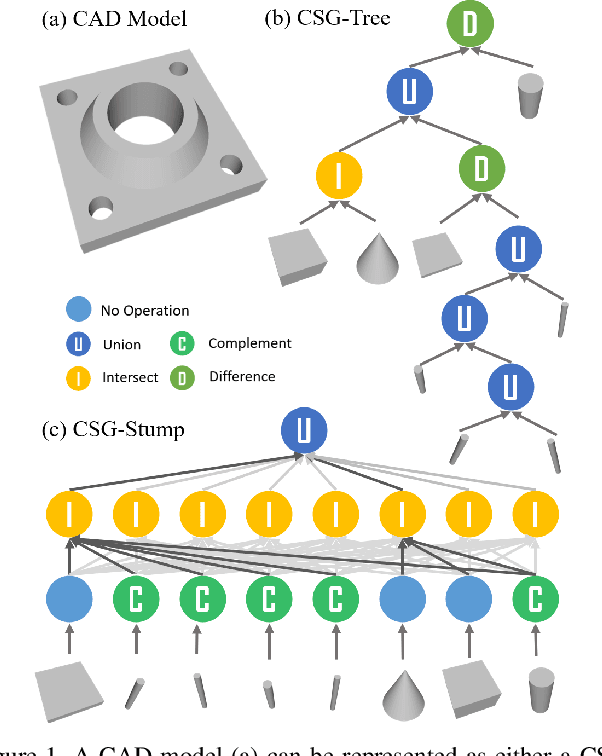

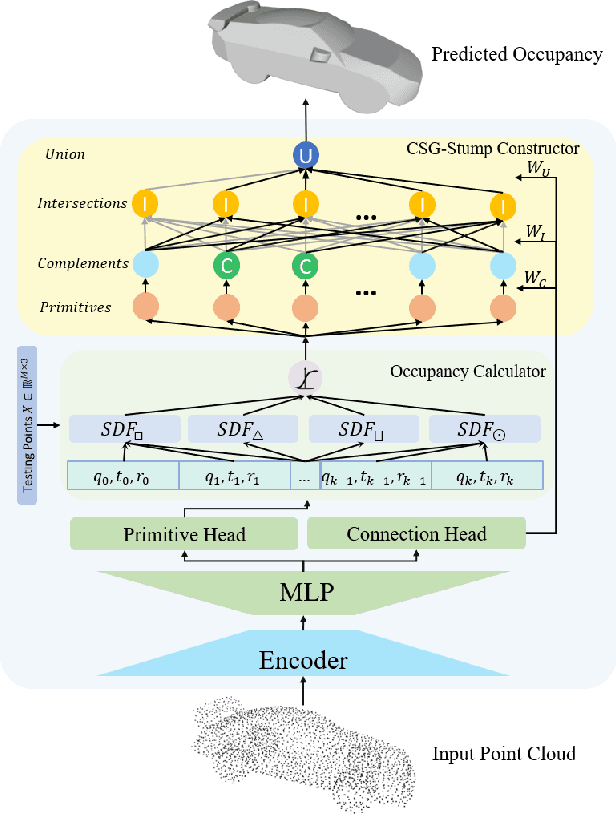
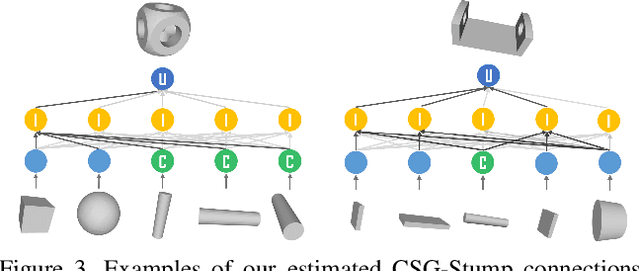
Abstract:Generating an interpretable and compact representation of 3D shapes from point clouds is an important and challenging problem. This paper presents CSG-Stump Net, an unsupervised end-to-end network for learning shapes from point clouds and discovering the underlying constituent modeling primitives and operations as well. At the core is a three-level structure called {\em CSG-Stump}, consisting of a complement layer at the bottom, an intersection layer in the middle, and a union layer at the top. CSG-Stump is proven to be equivalent to CSG in terms of representation, therefore inheriting the interpretable, compact and editable nature of CSG while freeing from CSG's complex tree structures. Particularly, the CSG-Stump has a simple and regular structure, allowing neural networks to give outputs of a constant dimensionality, which makes itself deep-learning friendly. Due to these characteristics of CSG-Stump, CSG-Stump Net achieves superior results compared to previous CSG-based methods and generates much more appealing shapes, as confirmed by extensive experiments. Project page: https://kimren227.github.io/projects/CSGStump/
Towards Complex and Continuous Manipulation: A Gesture Based Anthropomorphic Robotic Hand Design
Dec 20, 2020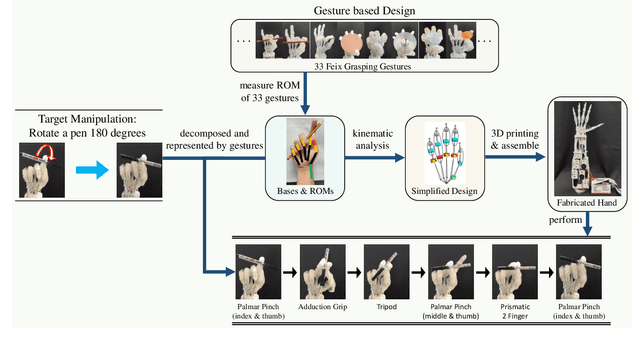
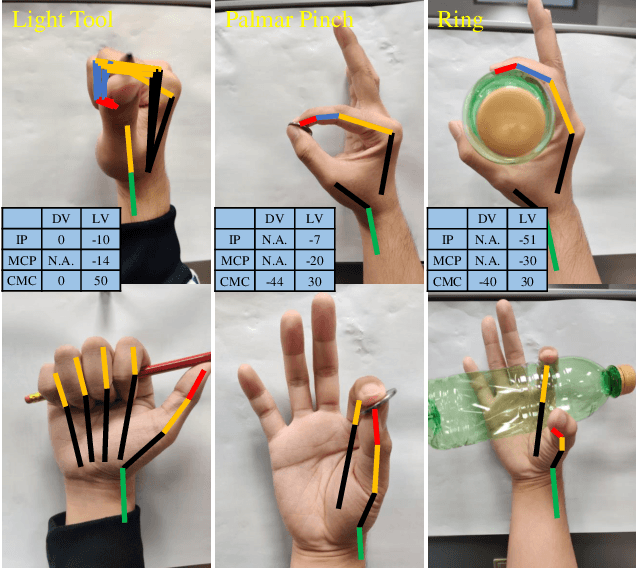
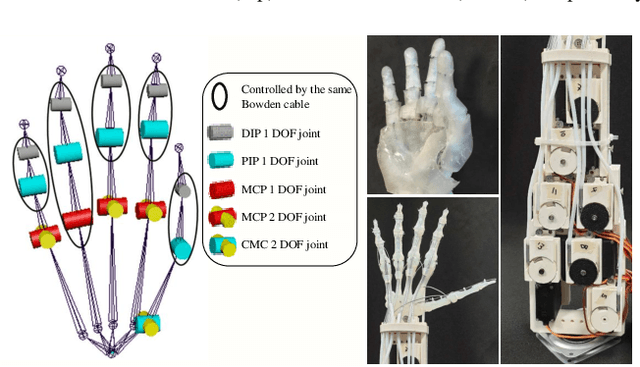
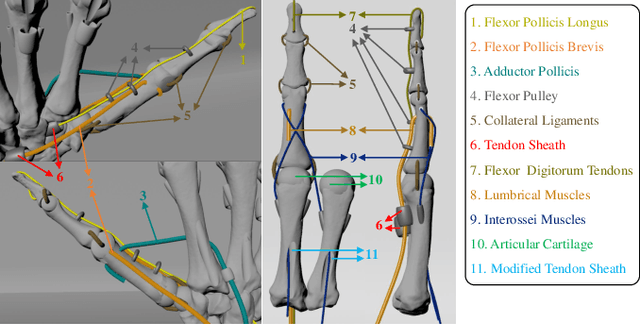
Abstract:Most current anthropomorphic robotic hands can realize part of the human hand functions, particularly for object grasping. However, due to the complexity of the human hand, few current designs target at daily object manipulations, even for simple actions like rotating a pen. To tackle this problem, we introduce a gesture based framework, which adopts the widely-used 33 grasping gestures of Feix as the bases for hand design and implementation of manipulation. In the proposed framework, we first measure the motion ranges of human fingers for each gesture, and based on the results, we propose a simple yet dexterous robotic hand design with 13 degrees of freedom. Furthermore, we adopt a frame interpolation based method, in which we consider the base gestures as the key frames to represent a manipulation task, and use the simple linear interpolation strategy to accomplish the manipulation. To demonstrate the effectiveness of our framework, we define a three-level benchmark, which includes not only 62 test gestures from previous research, but also multiple complex and continuous actions. Experimental results on this benchmark validate the dexterity of the proposed design and our video is available in \url{https://entuedu-my.sharepoint.com/:v:/g/personal/hanhui_li_staff_main_ntu_edu_sg/Ean2GpnFo6JPjIqbKy1KHMEBftgCkcDhnSX-9uLZ6T0rUg?e=ppCGbC}
Fast 3D Modeling of Anthropomorphic Robotic Hands Based on A Multi-layer Deformable Design
Nov 07, 2020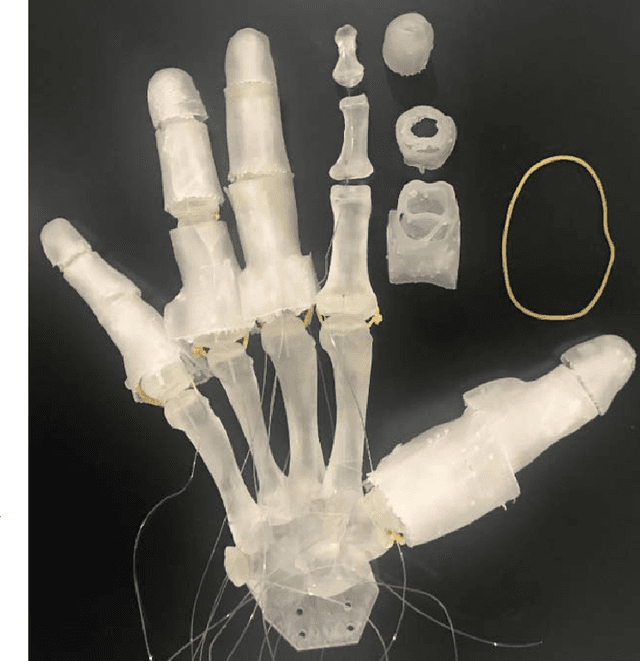
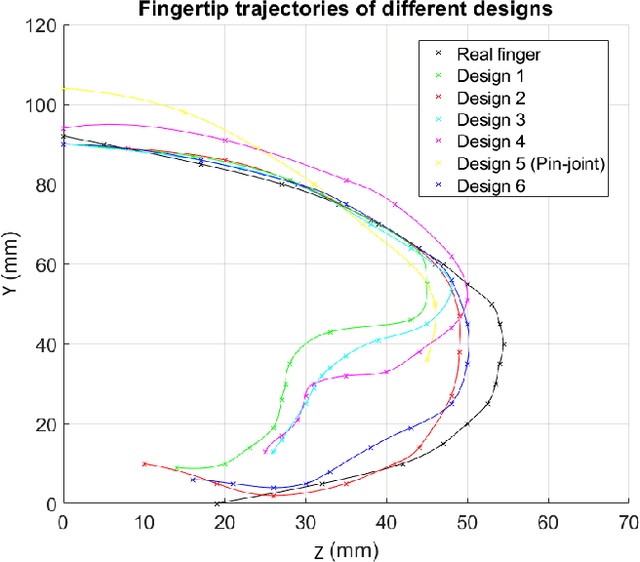
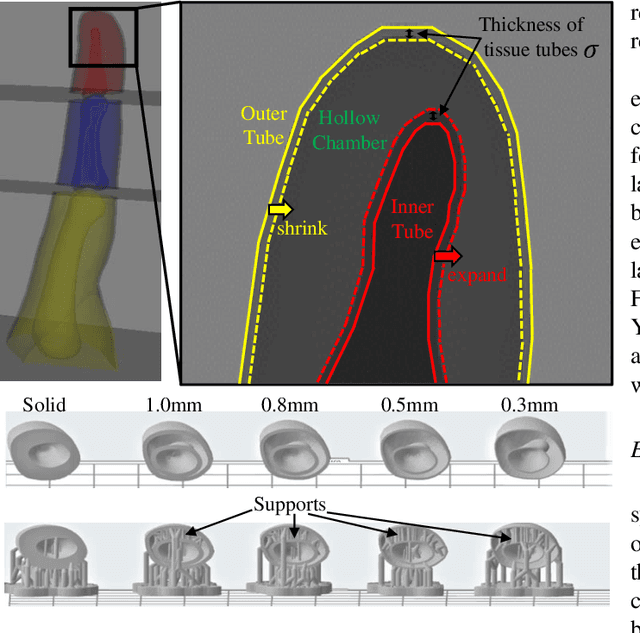
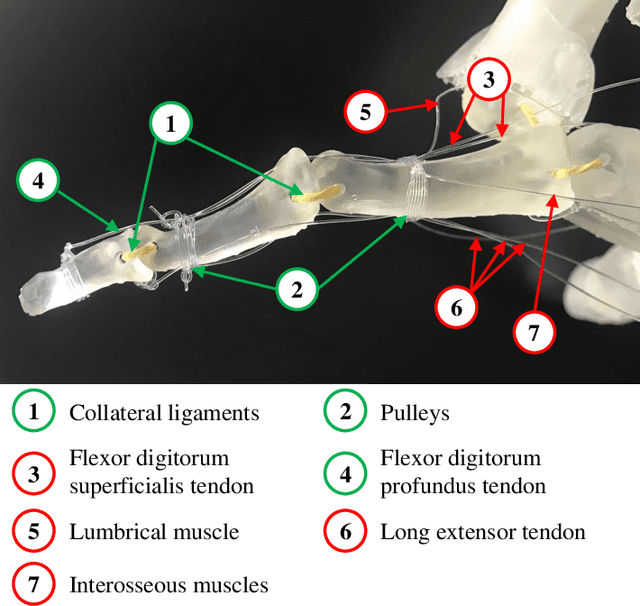
Abstract:Current anthropomorphic robotic hands mainly focus on improving their dexterity by devising new mechanical structures and actuation systems. However, most of them rely on a single structure/system (e.g., bone-only) and ignore the fact that the human hand is composed of multiple functional structures (e.g., skin, bones, muscles, and tendons). This not only increases the difficulty of the design process but also lowers the robustness and flexibility of the fabricated hand. Besides, other factors like customization, the time and cost for production, and the degree of resemblance between human hands and robotic hands, remain omitted. To tackle these problems, this study proposes a 3D printable multi-layer design that models the hand with the layers of skin, tissues, and bones. The proposed design first obtains the 3D surface model of a target hand via 3D scanning, and then generates the 3D bone models from the surface model based on a fast template matching method. To overcome the disadvantage of the rigid bone layer in deformation, the tissue layer is introduced and represented by a concentric tube based structure, of which the deformability can be explicitly controlled by a parameter. Besides, a low-cost yet effective underactuated system is adopted to drive the fabricated hand. The proposed design is tested with 33 widely used object grasping types, as well as special objects like fragile silken tofu, and outperforms previous designs remarkably. With the proposed design, anthropomorphic robotic hands can be produced fast with low cost, and be customizable and deformable.
Modeling Caricature Expressions by 3D Blendshape and Dynamic Texture
Aug 13, 2020



Abstract:The problem of deforming an artist-drawn caricature according to a given normal face expression is of interest in applications such as social media, animation and entertainment. This paper presents a solution to the problem, with an emphasis on enhancing the ability to create desired expressions and meanwhile preserve the identity exaggeration style of the caricature, which imposes challenges due to the complicated nature of caricatures. The key of our solution is a novel method to model caricature expression, which extends traditional 3DMM representation to caricature domain. The method consists of shape modelling and texture generation for caricatures. Geometric optimization is developed to create identity-preserving blendshapes for reconstructing accurate and stable geometric shape, and a conditional generative adversarial network (cGAN) is designed for generating dynamic textures under target expressions. The combination of both shape and texture components makes the non-trivial expressions of a caricature be effectively defined by the extension of the popular 3DMM representation and a caricature can thus be flexibly deformed into arbitrary expressions with good results visually in both shape and color spaces. The experiments demonstrate the effectiveness of the proposed method.
 Add to Chrome
Add to Chrome Add to Firefox
Add to Firefox Add to Edge
Add to Edge